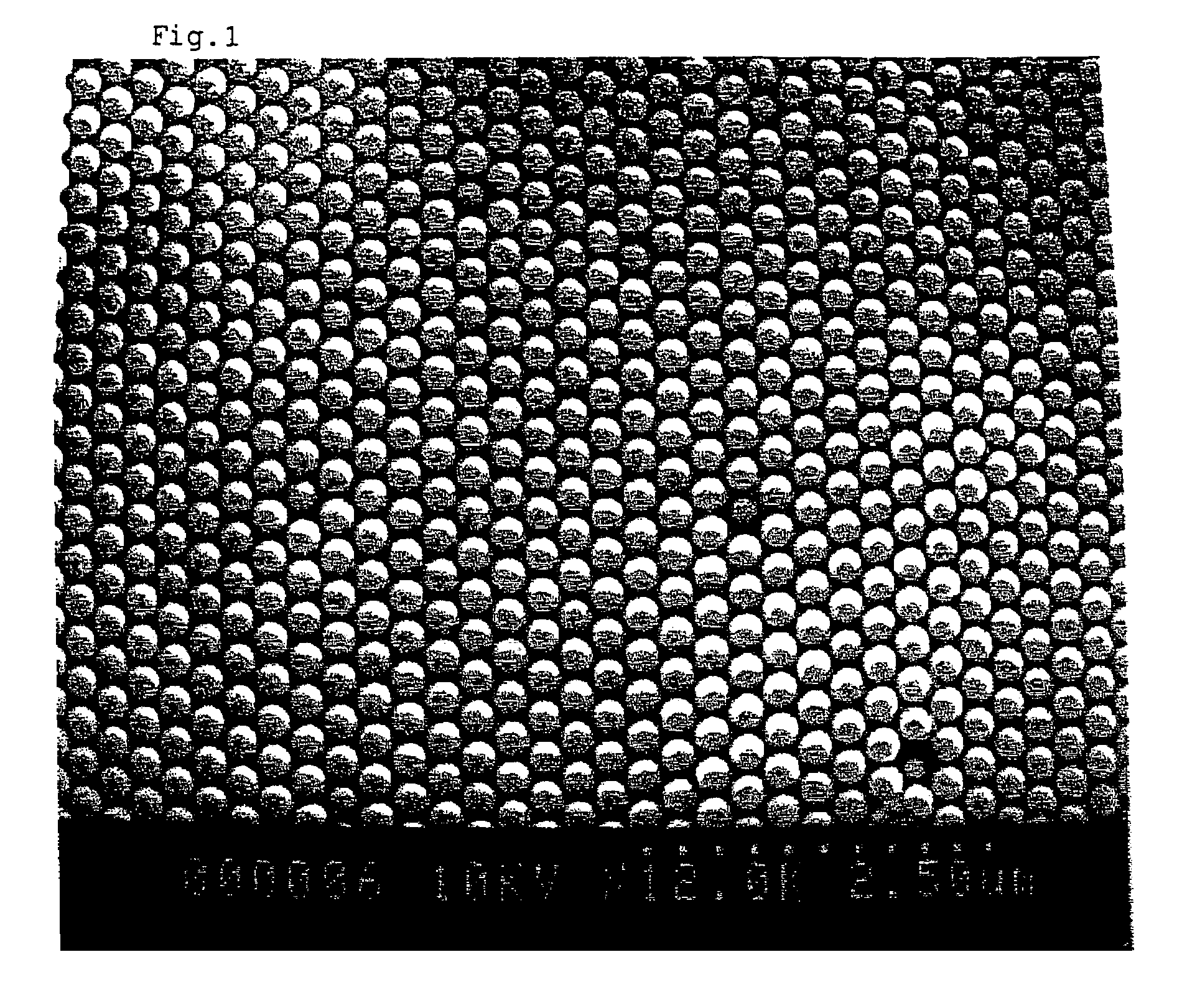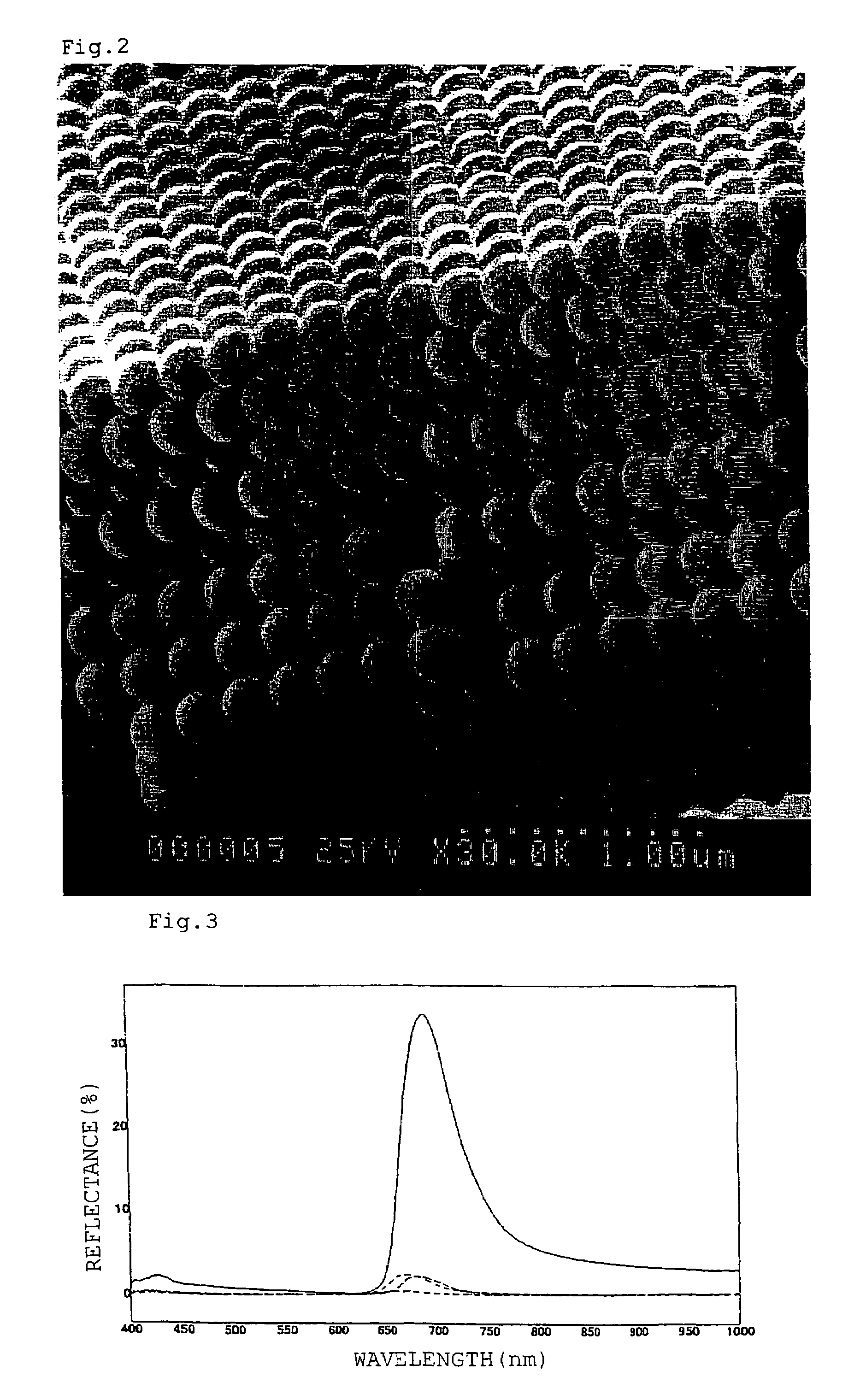Fluid colloid crystal and process for producing three-dimensional aligned particle mass therefrom
a colloidal crystal and colloidal crystal technology, applied in chemical/physical processes, natural mineral layered products, synthetic resin layered products, etc., can solve the problems of increasing the tendency of occurrence of such cracks due to shrinkage on drying, affecting the purity of the ordered structure, and preventing longitudinal and lateral random alignment of particles. , the effect of enhancing the intensity of surface charg
- Summary
- Abstract
- Description
- Claims
- Application Information
AI Technical Summary
Benefits of technology
Problems solved by technology
Method used
Image
Examples
reference example 1
[0193]Monodisperse spherical particles of a black color type achromatic color for use in the invention were prepared. In a 1-liter four-necked flask, 100 parts by weight of methyl methacrylate (MMA) as a monomer, 7.5 parts by weight of C.I Solvent Black 27 as a black dye, 0.6 part by weight of sodium dodecylbenzenesulfonate and 290 parts by weight of water were placed, then they were stirred and mixed, and the mixture was heated to 80° C. with stirring under purging of the flask with nitrogen. Then, 0.5 part by weight of potassium persulfate was added, and polymerization reaction was performed at 80° C. for about 7 hours. In the suspension (S1) obtained by this soap-free emulsion polymerization, black polymer particles which were almost monodisperse spherical particles having a mean volume diameter, as measured by an electron microscope method and expressed on the volume basis, of 180 nm were contained. The volume concentration of the diepersoid particles in the suspension (S1) was ...
example 1
[0194]From the suspension (S1), impurities such as an unreacted monomer and an emulsifying agent were removed, and the suspension (S1) was subjected to dialysis to reduce the electrical conductivity to 400 μS / cm from the initial value of 4000 μS / cm. The thus dialyzed suspension was gradually concentrated to a volume concentration of 36%. At this time, the visually sensed color of the solid-liquid colloidal dispersion (suspension) in the vertical direction was a spectral diffraction color of green.
example 2
[0195]In a 1-lieter four-necked flask, 80 parts by weight of MMA and 1.0 part by weight of benzoyl peroxide were placed to give a solution, then 200 parts by weight of water, 3.3 parts by weight of polyoxyethylene polycyclic phenyl ether sulfuric ester salt as an emulsifying agent and 6.5 parts by weight of C.I Solvent Black 27 as a black dye were added, and they were mixed with vigorous stirring. Subsequently, to the mixture were added 28.6 parts by weight of the suspension (S1) obtained in Reference Example 1. The resulting mixture was mildly stirred at 50° C. for 0.5 hour and then reacted at 75° C. for 1.5 hours to obtain a suspension (S2) of polymer particles. In the resulting suspension (S2), black polymer particles which were monodisperse spherical particles having a mean volume diameter, as measured by an electron microscope method and expressed on the volume basis, of 200 nm were formed. The volume concentration of the solids was 21%. From the suspension, impurities such as ...
PUM
| Property | Measurement | Unit |
|---|---|---|
| mean volume diameter | aaaaa | aaaaa |
| electrical conductivity | aaaaa | aaaaa |
| mean volume diameter | aaaaa | aaaaa |
Abstract
Description
Claims
Application Information
 Login to View More
Login to View More - R&D
- Intellectual Property
- Life Sciences
- Materials
- Tech Scout
- Unparalleled Data Quality
- Higher Quality Content
- 60% Fewer Hallucinations
Browse by: Latest US Patents, China's latest patents, Technical Efficacy Thesaurus, Application Domain, Technology Topic, Popular Technical Reports.
© 2025 PatSnap. All rights reserved.Legal|Privacy policy|Modern Slavery Act Transparency Statement|Sitemap|About US| Contact US: help@patsnap.com



